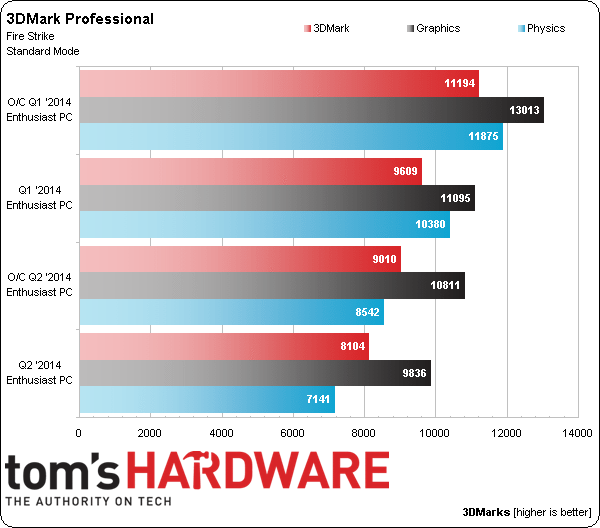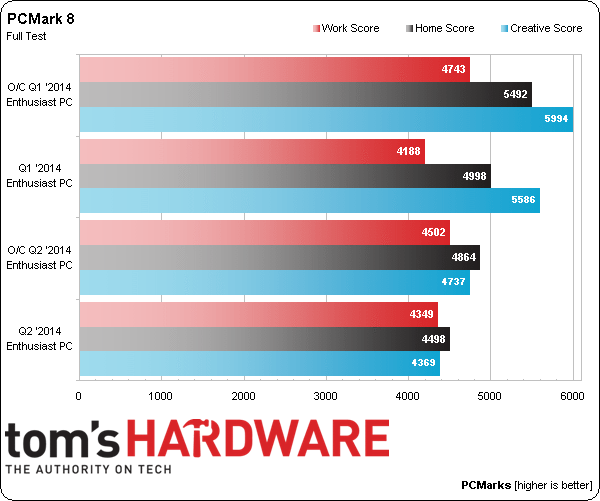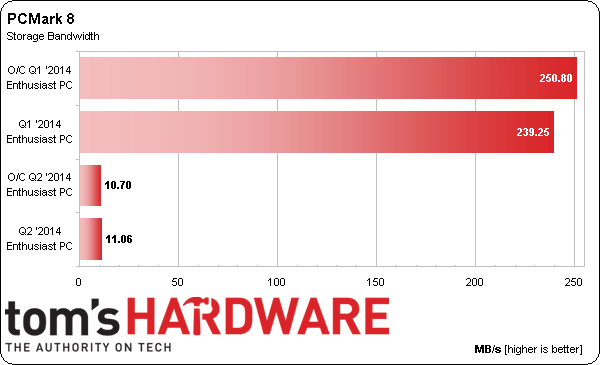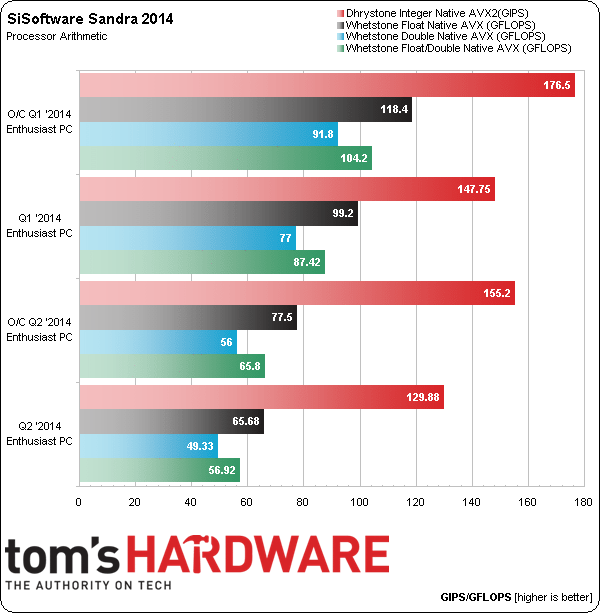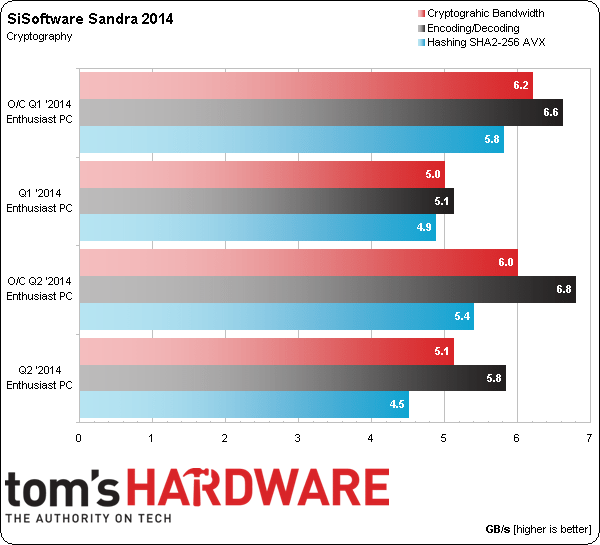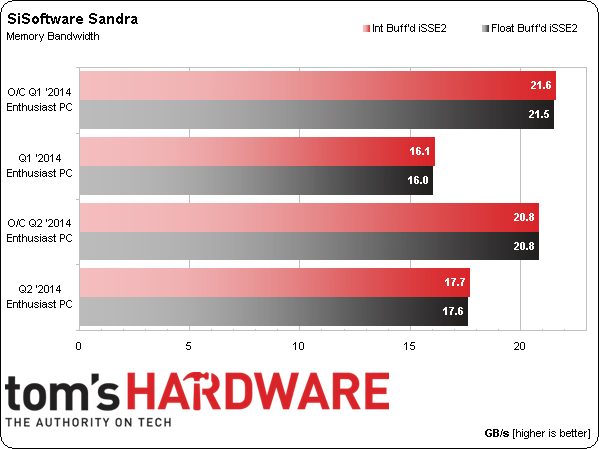System Builder Marathon, Q2 2014: Our Enthusiast PC
Results: Synthetics
We begin our benchmark analysis with a handful of synthetic tests designed to emphasize differences between the various subsystems that changed between last quarter's configuration and this PC. Notably, the Core i7-4770K should perform better in well-threaded metrics.
It remains to be seen how the GeForce GTX 780 Ti and Radeon R9 290 fare against each other, though I'd expect the GK110-based board to be faster in most measurements.
When we break down the test's individual components, we can see the Physics suite, in blue, heavily favors the Core i7, while the Graphics component, in black, puts the GeForce in first place. Those two scores play into the overall 3DMark result, in red, which naturally reflects an advantage for last quarter's PC.
My previous machine also enjoys a clear advantage in PCMark 8's Home and Creative benchmark tests, while the Work suite appears to be limited by some other variable.
This quarter's build suffers greatly for its mechanical disk drive. You're not going to see storage play a huge role in the rest of our benchmark results. However, the above chart illustrates that you're going to wait a lot longer for Windows to boot and your favorite applications to load.
Intel's Core i5-4670K can't keep up with the Core i7-4770K in Sandra's Arithmetic module, which obviously takes advantage of as many logical processors as possible. Both Haswell-based CPUs support similar ISAs.
When it comes to the Cryptography test, however, other factors come into play. The Encoding/Decoding benchmark is accelerated by AES-NI, so performance is dictated by the rate at which system memory can feed data into the CPU. Sandra's Hashing test depends more on ISA support and clock rate.
Get Tom's Hardware's best news and in-depth reviews, straight to your inbox.
And here are the numbers largely responsible for that Cryptography score. My newer build's memory defaults to 1333 MT/s, while the XMP profile increases it to 1600 MT/s. Last quarter, I also used a 1333 MT/s default, while XMP helped me overclock to 1866 MT/s. Haswell isn't a particularly bandwidth-starved architecture though, so we're not expecting these exaggerated results to manifest as pointedly in the real-world tests.
Current page: Results: Synthetics
Prev Page How We Tested Our Mainstream Enthusiast System Next Page Results: Media TranscodingDon Woligroski was a former senior hardware editor for Tom's Hardware. He has covered a wide range of PC hardware topics, including CPUs, GPUs, system building, and emerging technologies.
-
BilinearCheese I have to say guys, that enthusiast level build is terrible. Apevia case? Turbo Duo 290? NO SSD? Come on. For 16 bucks less I put together a system WITH an SSD, a decent case, a much better 290, and a better motherboard/cpu cooler. Hell, I even managed to get a color scheme together for it as well:Reply
http://pcpartpicker.com/p/FRyNgs
"Terrible" = same CPU, cooler, graphics card, and equal benchmark performance?
The case we chose really doesn't matter, as the first page of article points out. Case/optical drive is completely subjective. That's exactly why we've separated the performance parts price from case/optical/OS.
By the way, are you just assuming Apevia its bad because you prefer other well-known brands? It did a fantastic job for the purposes of this article, so other than brand, what's your issue with it? Is brand the same problem you have with the 290? Because it's cooler is quite good.
Speaking of coolers, the Hyper 212 EVO is virtually the 212 plus with a different fan. Is this really the huge difference you're implying it is?
You're also specing it out two months after we did, with lower prices. An SSD would have been great, but two months ago when we ordered there was no room in the budget, and we weren't willing to sacrifice the 290.
Bottom line, you're being a little sensationalist about picking nits. -
itzsnypah When overclocking the CPU are you leaving the uncore coupled to the core multiplier or uncoupled and set at x34/36? You averaging nearly 1.3v for only 4.3Ghz is very poor.Reply -
I have to question the need for Z97 mobo. If you go with the Haswell and not the Haswell update and you do not include M.2 SSD, then why go with Z97? If you are choosing the Z97 to have a upgrade path, you should also go for the Devil's Canyon cpu. Budget-wise it is a really bad idea to even think about going for D.C. Haswell chip later on.Reply
The ssd gives you an easily felt sensation of speed every time you boot. Just got an ssd myself like 2 months ago. Any other go-fast parts come secondary. Ditch the Z97 and the ODD and you could squeeze in a SSD. -
envy14tpe @BilinearCheese. I believe all parts for these toms' builds have to be from Newegg. So, try building that way.Reply -
BilinearCheese Reply@BilinearCheese. I believe all parts for these toms' builds have to be from Newegg. So, try building that way.
How is this the best suggested build for the money if you're only locking it to one retailer? That's...kinda silly
-
Crashman Reply
Because if we get all our parts from Newegg, it's Newegg's money? Because, when Newegg pays for the parts, we can afford to give the entire systems away?@BilinearCheese. I believe all parts for these toms' builds have to be from Newegg. So, try building that way.
How is this the best suggested build for the money if you're only locking it to one retailer? That's...kinda silly
:p
-
envy14tpe ReplyBecause if we get all our parts from Newegg, it's Newegg's money? Because, when Newegg pays for the parts, we can afford to give the entire systems away?
:p
No one will ever question your parts selection ever again!! Maybe add a side note on price page that all parts are from/ must be bought on Newegg. -
BilinearCheese ReplyBecause if we get all our parts from Newegg, it's Newegg's money? Because, when Newegg pays for the parts, we can afford to give the entire systems away?
:p
All newegg, still cheaper with better components:
http://pcpartpicker.com/p/pj7bCJ
What's the next rule, no rebates? -
Crashman ReplyAll newegg, still cheaper with better components:
http://pcpartpicker.com/p/pj7bCJ
What's the next rule, no rebates?
No mail-in rebates because they usually disappear before we can publish and, because when you have $100 you can't buy a $149 part that has a $50 MIR :)
Instant rebates and sales are fine because when the discount on one part disappears, the discount on another part appears.
BTW, I like the look of your case. I never understood what the deal was with don and ugly cases, but he's Canadian so I know better than to ask. -
BilinearCheese ReplyNo mail-in rebates because they usually disappear before we can publish and, because when you have $100 you can't buy a $149 part that has a $50 MIR :)
Instant rebates and sales are fine because when the discount on one part disappears, the discount on another part appears.
Even with that in mind, my second build without rebates totals 1178. Changing the motherboard to a z87 Extreme3 (because z97 isn't a benefit if you're not going for haswell refresh or an ssd) and it's 3 bucks more than the build listed.

